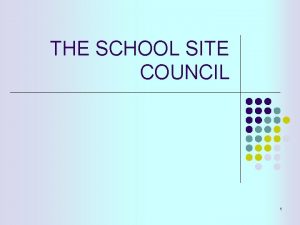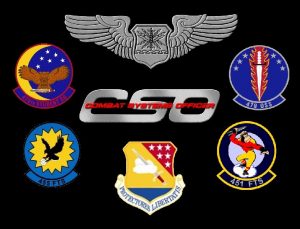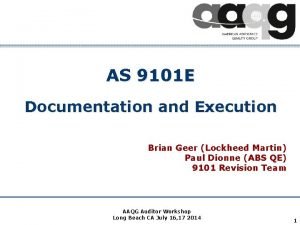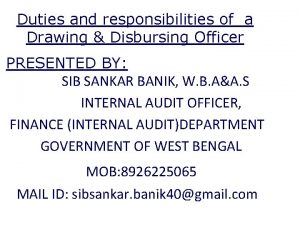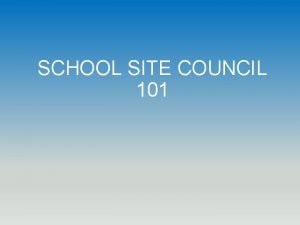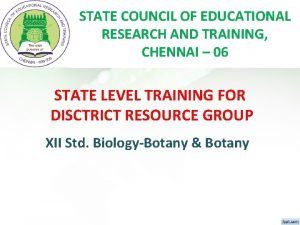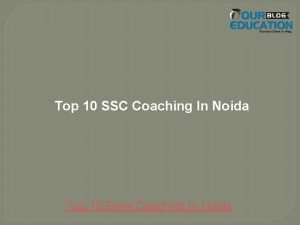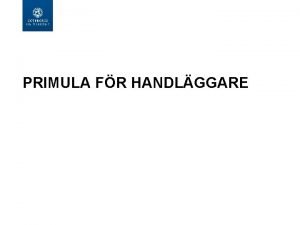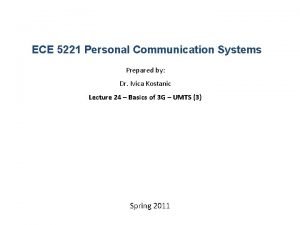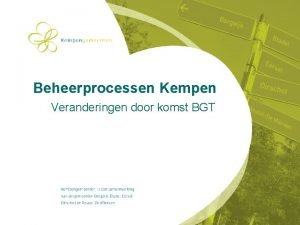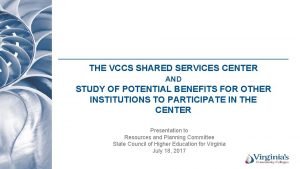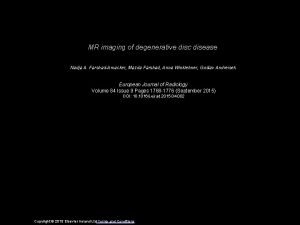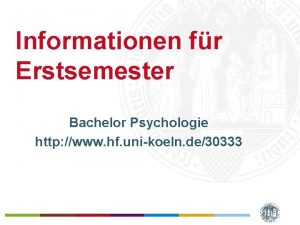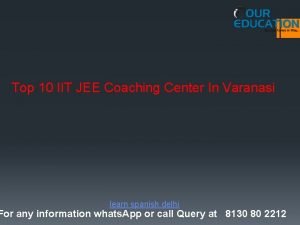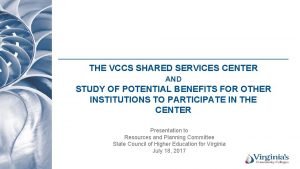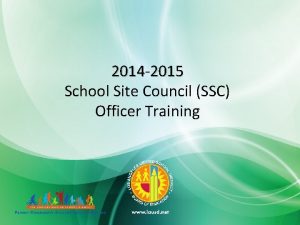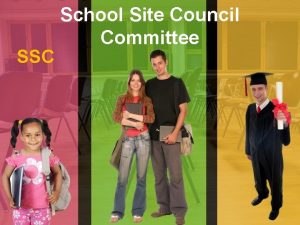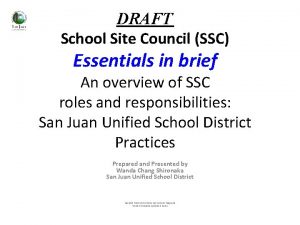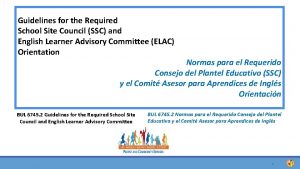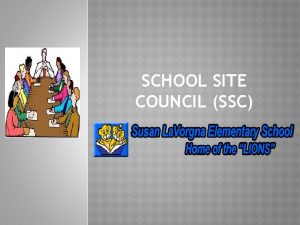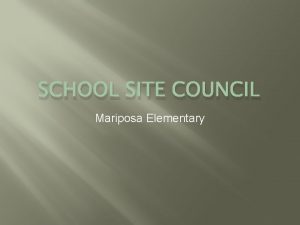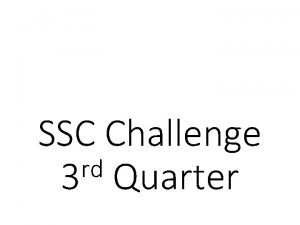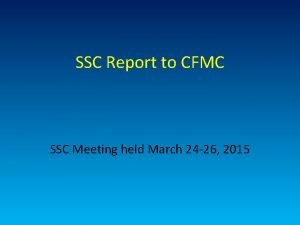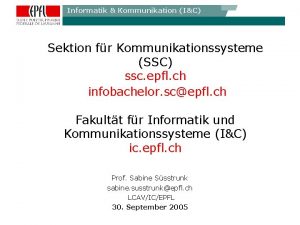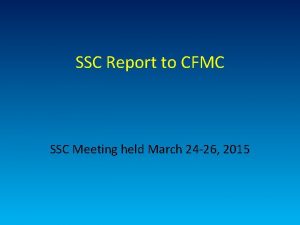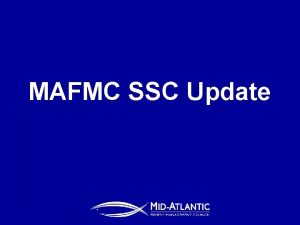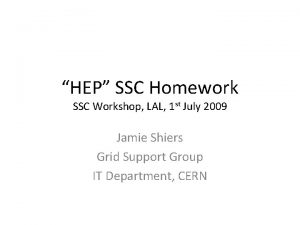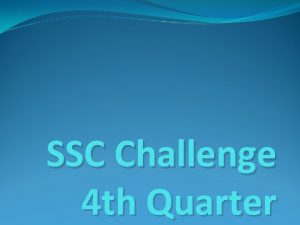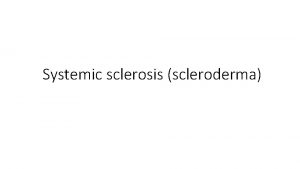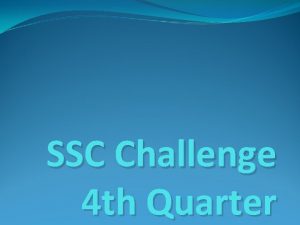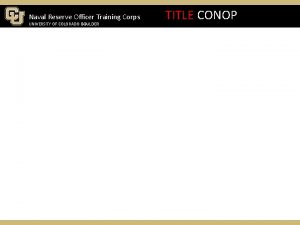2013 2014 School Site Council SSC Officer Training
































- Slides: 32

2013 -2014 School Site Council (SSC) Officer Training

2 Objectives This presentation provides: 1. School Site Council (SSC) composition requirements 2. roles and responsibilities of the SSC 3. guidelines for writing, monitoring, and evaluating the effectiveness of the Single Plan for Student Achievement (SPSA) 4. guidelines for conducting SSC meetings

3 Objective #1 SSC Composition

4 Elementary SSC Composition Minimum 10 members Principal 1 seat Parents* 5 seats Teachers 3 seats Other Staff 1 seat *Parents may vote to give up one or more of their seats to community members. See BUL 5797. 1 for more information Teachers constitute the majority of school staff represented on the SSC

5 Secondary SSC Composition Minimum 12 members **Middle schools must include students, unless indicated in their bylaws Principal 1 seat Students** 3 seats Teachers 4 seats Parents* 3 seats Other Staff 1 seat *Parents may vote to give up one or more of their seats to community members. See BUL 5797. 1 for more information Teachers constitute the majority of school staff represented on the SSC

6 Objective #2 Roles and Responsibilities of the School Site Council (SSC)

7 SSC Officer Roles CHAIRPERSON Organizes, convenes, and leads meetings of the Council; collaborates to develop agendas VICE-CHAIRPERSON Presides in the absence of the Chairperson; possible successor to Chair if stated in bylaws SECRETARY PARLIAMENTARIAN Records events and actions taken at Council meetings; brings documents to meetings; signs/ dates minutes Resolves questions of procedure, often with the help of “Robert’s Rules of Order; ” supports Greene Act/bylaws

8 Responsibilities of the SSC Annually review meeting operating procedures Ongoing basis become knowledgeable of state and local issues related to assessment, curriculum, and instruction review bylaws communicate regularly with representative stakeholder groups develop an annual meeting calendar may appoint committees to perform tasks to assist in developing, monitoring, and evaluating the SPSA

9 Primary Function of SSC A small part of monitoring the SPSA includes addressing how school funds should best be spent to meet students’ academic needs. But, the primary function of the SSC is to monitor the effectiveness of the SPSA and suggest changes to the plan as necessary.

10 Primary Responsibility of SSC Single Plan for Student Achievement SSC responsibilities include: • developing the Single Plan for Student Achievement (Ed. Code 52853, 64001) • approving the Plan • recommending it to the local governing board for approval • monitoring its implementation • evaluating the effectiveness of the planned activities at least annually Source: Guide to the Single Plan for Student Achievement California Department of Education, February 2013

11 Objective #3 Single Plan for Student Achievement (SPSA) Guidelines

12 The intent of the Single Plan for Student Achievement (SPSA) is to create a cycle of continuous improvement of student performance, and to ensure that all students succeed in reaching state academic standards.

13 Continuous Improvement Cycle Analyze student data. Monitor and evaluate effectiveness of the implementation. Receive local governing board approval. Implement SPSA. Recommend SPSA to local governing board. Source: Guide to the Single Plan for Student Achievement California Department of Education, February 2013 Measure effectiveness of current STRATEGIES to determine causes of student underachievement. Identify achievement GOALS. Create ACTION/TASK timelines, including persons responsible, & expenses for implementation.

14 Step 1 Analyze Student Achievement Data Sources of data: • state (e. g. CELDT, CAHSEE, State Standardized Tests) • district (e. g. benchmark, End-of-Course Exams, Performance Meter, School Experience Survey) • school generated (e. g. teachercreated, department-created) Source: Guide to the Single Plan for Student Achievement California Department of Education, February 2013

15 Step 2 Measure Effectiveness of Current Improvement Strategies Determine critical causes of student underachievement, as reflected in the data, with the input of all stakeholders, including advisory committees. Meeting minutes should reflect that stakeholders were included in the process of reviewing the SPSA. Source: Guide to the Single Plan for Student Achievement California Department of Education, February 2013

16 Step 3 Identify Achievement Goals and Key Improvement Strategies Align work with the District goals. Focus selected goals on the following: – Derived from the conclusions of the needs assessment – Prioritized by student need – Realistic and attainable – Specific to the needs of students – Measureable by frequent formative assessments Source: Guide to the Single Plan for Student Achievement California Department of Education, February 2013

17 Goals, Strategies, Actions & Tasks Action Step/Task Strategy Action Step/Task School Goal Strategy Action Step/Task LEA Goal SPSA LEA Goal School Goal Action Step/Task Strategy LEA Goal Action Step/Task School Goal Strategy Action Step/Task The SPSA consists of goals, strategies, action steps, and tasks that, ultimately, stem from and relate to LAUSD’s goal of high academic achievement for all students.

18 Step 4 Define Timelines, Personnel Responsible, Proposed Expenditures, and Funding Sources to Implement the Plan • For each Goal, defined Strategies and Action Steps/Tasks must be set as progress markers. • Be specific about the person(s) responsible and completion deadlines. • Provide supplemental services only—do not allocate funds to pay for what could, or should, be provided with general funds. Source: Guide to the Single Plan for Student Achievement California Department of Education, February 2013

19 Step 5 Recommend the SPSA to the Local Governing Board The governing board wants assurance that the SSC has addressed its legal responsibilities through: • proper constitution • evidence that input has been sought from stakeholders • a tailored Single Plan based on student need • a formally approved the plan Source: Guide to the Single Plan for Student Achievement California Department of Education, February 2013

20 Step 6 Implement the Plan The site administrator is responsible for implementing and evaluating the activities outlined in the plan. This may include: • assigning, directing, & supervising responsible staff • purchasing materials and equipment • accounting for allocated funds Source: Guide to the Single Plan for Student Achievement California Department of Education, February 2013

21 Step 7 Monitor Implementation Clear timelines with tasks, and persons responsible make monitoring much easier. A plan that is too general runs the risk of diminishing student achievement results. As the implementation of the plan unfolds, the SSC should evaluate the progress of each major strategy for identified students and share this information with stakeholders. Source: Guide to the Single Plan for Student Achievement California Department of Education, February 2013

22 Continue the Cycle At least annually, the SSC must evaluate the effectiveness of planned activities. SSC meeting minutes should reflect the evaluation. In the cycle of continuous improvement of student performance, evaluation of the results of goals will provide data for the following year’s plan. Source: Guide to the Single Plan for Student Achievement California Department of Education, February 2013

23 Objective #4 Conducting SSC Meetings

24 SSC Chairperson redirects discussion to the question when a motion is before the Council explains what the effect of a motion would be if it is not clear to every member provides leadership on behalf of the Council and the community it serves The SSC Chairperson… recognizes people who desire to speak, and protects from disturbance or interference calls the meeting to order and closes meeting at the appointed time enforces policies relating to the conduct of meetings and helps ensure compliance with the bylaws follows the order of posted agenda, clearly announcing transitions and items

25 Essentials • Post the agenda 72 hours in advance (or 24 hours in advance in the case of an emergency meeting), specifying the date, time, location, and each item of business, especially if an action (vote) will be taken • Agenda must be posted inside and outside of the building where the meeting will take place in view of the public • Create sign-in sheets showing identification of stakeholders and officers • Have all materials translated and interpretation service requested (Ed Code 48985) • Have enough copies of the meeting materials available for the public upon request • Read/be familiar with SSC bylaws

26 Essentials • Follow the posted agenda, being sure to identify which items need action (a vote) – Exception: If an action is needed and was not known at the time the agenda was posted, the SSC may, by unanimous vote, add the item on the agenda for action • Follow agreed-upon operating procedures, clarifying with the Parliamentarian when necessary (e. g. Robert’s Rules of Order, LAUSD Norms and Operating Procedures) • Do not alter minutes after the Council has approved them, making them an official record of the meeting • Allow the public to address the Council on any matter within the jurisdiction of the Council during the Public Comments section of the agenda

27 Conducting the Meeting Call to Order • The meeting is first called to order. Second, members are welcomed. Next, roll call is taken. Finally, quorum is/is not established. ‒ Quorum is the number of members that must be legally present in order to conduct business, 50% of the membership total + 1 member If a quorum is not present, the Chair waits until there is quorum, or until after a reasonable time, there appears to be no prospect that a quorum will assemble. If quorum cannot be obtained, the Chair calls the meeting to order, announces the absence of a quorum, and entertains a motion to adjourn, recess, or have an informational meeting.

28 Conducting the Meeting Motions • Matters/Issues must be considered in order. • Two types of motions: main and subsidiary. Both motions need a “second. ” Main motion: brings business before the assembly. Main motions can only be made when no other motion is pending and must be directly related to the issue under consideration. Subsidiary motion: assist in considering or rejecting a main motion (e. g. motions to postpone, refer to committee, table). Subsidiary motions must directly relate to the main motion. • After a motion’s first reading, the Chairperson should inquire, “Is there any discussion? ” • The maker of a motion has the first right to speak and to amend it.

29 Conducting the Meeting • • Voting Agenda needs to indicate when an action/vote will occur, prior to posting of the agenda Chair should clearly announce the results of the voting Minutes should reflect number of votes in favor, against, and abstentions A tie vote is a “lost” vote because no majority was obtained

30 After the Meeting • Publish and distribute signed and dated minutes within a week • Maintain all records for 5 years • Furnish copies of meeting minutes or any other Council document to members or the public upon request (Greene Act) • Determine next meeting’s agenda items • Members take collective responsibility for their performance

31 3 -2 -1 What are 3 things have you learned? What 2 ideas do you have about your What is specific officer role? 1 goal do you have for SSC this school year?

32 We THANK YOU for participating!
 Duties of polling officer in election 2014
Duties of polling officer in election 2014 School site council
School site council Hot site cold site warm site disaster recovery
Hot site cold site warm site disaster recovery Chief data officer training
Chief data officer training Casualty assistance officer training
Casualty assistance officer training Uct air force
Uct air force 9101e 9101 2014 training
9101e 9101 2014 training Disbursing officer job description government
Disbursing officer job description government Student site council
Student site council State council of educational research and training
State council of educational research and training Summer school 2013
Summer school 2013 Education is not mere bookish knowledge
Education is not mere bookish knowledge Ssc coaching in noida sector 62
Ssc coaching in noida sector 62 Gap filling without clues for ssc board question
Gap filling without clues for ssc board question Primula ssc
Primula ssc 01 ssc 2341
01 ssc 2341 01 ssc 5221
01 ssc 5221 Ssc dual enrollment
Ssc dual enrollment Www.ssc.cw
Www.ssc.cw A ship without a rudder right form of verb answer
A ship without a rudder right form of verb answer Objectives of teaching economics in secondary schools
Objectives of teaching economics in secondary schools Ssc de kempen
Ssc de kempen 01 ssc 1555
01 ssc 1555 Shared services center
Shared services center Oracle ssc
Oracle ssc Ssc logo
Ssc logo 01 ssc 1569
01 ssc 1569 Nadja farshad
Nadja farshad Ssc psychologie uni köln
Ssc psychologie uni köln Best iit coaching in varanasi
Best iit coaching in varanasi Vccs shared services
Vccs shared services 01 ssc 8562
01 ssc 8562 Ssc germanistik
Ssc germanistik

